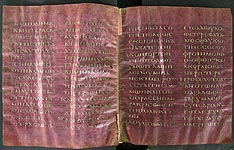Sarmisahly Tetraevangelion (Codex Purpureus Petropolitanus, Codex N, Codex Caesariensis).
6th cent. Constantinople, Imperial Skriptorium (?)
F (337 ı 288). I+182+I leaves. Both the beggining and the end are lost, several leaves are missing from divers parts of the codex.
Purple coloured parchment; paper (2 binding leaves). Silver, gold, ink.
It is written in a biblical uncial hand in two columns.
Text is written in silver. In nomina sacra and the chapter headings on the upper margins, the scribe used uncial smaller than the text script. Chapter are numbered in ink in the outer margins.
In accordance with the generally accepted opinion, the manuscript was created in Syria. However, Eugenia Granstrem, a noted specialist in the history and philology of Byzantium and the Slavs, considered that the codex had been produced in the Imperial Skriptorium at Constantinople, and its luxurious design proves this. The Sarmisahly Gospel took its name from the place where the main part of the codex was discovered at the end of the 19th century. Nevertheless, separate fragments from this manuscript were formerly known to scientists. Today some fragments from the same manuscript are preserved in several repositories other than the National Library of Russia, namely: 1) the Library of the Monastery of Saint John the Theologian on the Island of Patmos (33 leaves); 2) the Vatican Library in Rome (6 leaves); 3) the British Library in London (4 leaves); 4) the National Library of Austria in Vienna (2 leaves); 5) the Morgan Library in New York (1 leaf); 6) the Byzantine Museum in Athens (1 leaf); 7) the Museum of Byzantine Culture in Thessaloniki (1 leaf); 8) the private collection of Marquis ¿. Spinola in Lerma, Italy (1 leaf).
The sixth-century purple Gospel was bought by Emperor Nicholas II for the Imperial Public Library from the Greek community of the village of Sarmisahly with the assistance of the Russian Archaeological Institute in Constantinople. It entered the Imperial Public Library in 1896.
Shelfmark: –Õ¡ √˜. 537.





